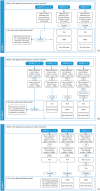Neglected femoral neck fractures in cerebral palsy: a narrative review
- PMID: 32071774
- PMCID: PMC7017596
- DOI: 10.1302/2058-5241.5.190019
Neglected femoral neck fractures in cerebral palsy: a narrative review
Abstract
Hip fractures are severe conditions with a high morbidity and mortality, especially when the diagnosis is delayed, and if formulated over 30 days after the injury, is termed a 'neglected femoral neck fracture' (NFNF).Cerebral palsy (CP) is probably one of the major risk factors for NFNF in Western countries, mainly because of both cognitive and motor impairments. However, considering the high prevalence of fractures in these patients, the incidence of NFNF in this population is probably underestimated, and this condition might result in persistent hip or abdominal pain.Several techniques are available for the treatment of NFNF (i.e. muscle pedicle bone graft, fixation with fibular graft, valgisation osteotomy), but most of them could affect motor function.Motor function must be preserved for as long as possible, in order to enhance the quality of life of CP patients.After discussing published NFNF cases in CP patients and available treatment options, a practical approach is proposed to facilitate the orthopaedic surgeon to both early identify and appropriately manage these challenging fractures. Cite this article: EFORT Open Rev 2020;5:58-64. DOI: 10.1302/2058-5241.5.190019.
Keywords: cerebral palsy; hip fracture; motor function; neglected femoral neck fracture; non-union.
© 2020 The author(s).
Conflict of interest statement
ICMJE Conflict of interest statement: GT reports payment for expert testimony, grants/grants pending, and travel/accommodation/meeting expenses unrelated to activities listed, all outside the submitted work. The other authors declare no conflict of interest relevant to this work.
Figures


References
-
- Meyers MH, Harvey JP, Jr, Moore TM. Delayed treatment of subcapital and transcervical fractures of the neck of the femur with internal fixation and a muscle pedicle bone graft. Orthop Clin North Am. 1974;5:743–756. - PubMed
-
- Huang CH. Treatment of neglected femoral neck fractures in young adults. Clin Orthop Relat Res. 1986:117–126. - PubMed
-
- Sandhu HS, Sandhu PS, Kapoor A. Neglected fractured neck of the femur: a predictive classification and treatment by osteosynthesis. Clin Orthop Relat Res. 2005:14–20. - PubMed
-
- Magu NK, Singh R, Sharma AK, Ummat V. Modified Pauwels’ intertrochanteric osteotomy in neglected femoral neck fractures in children: a report of 10 cases followed for a minimum of 5 years. J Orthop Trauma. 2007;21:237–243. - PubMed
-
- Ayoub MA, Gad HM. Neglected neck femur fractures in adolescents and young adults: factors predicting the surgical outcome. J Orthop Sci. 2013;18:93–100. - PubMed
Publication types
LinkOut - more resources
Full Text Sources
Miscellaneous

